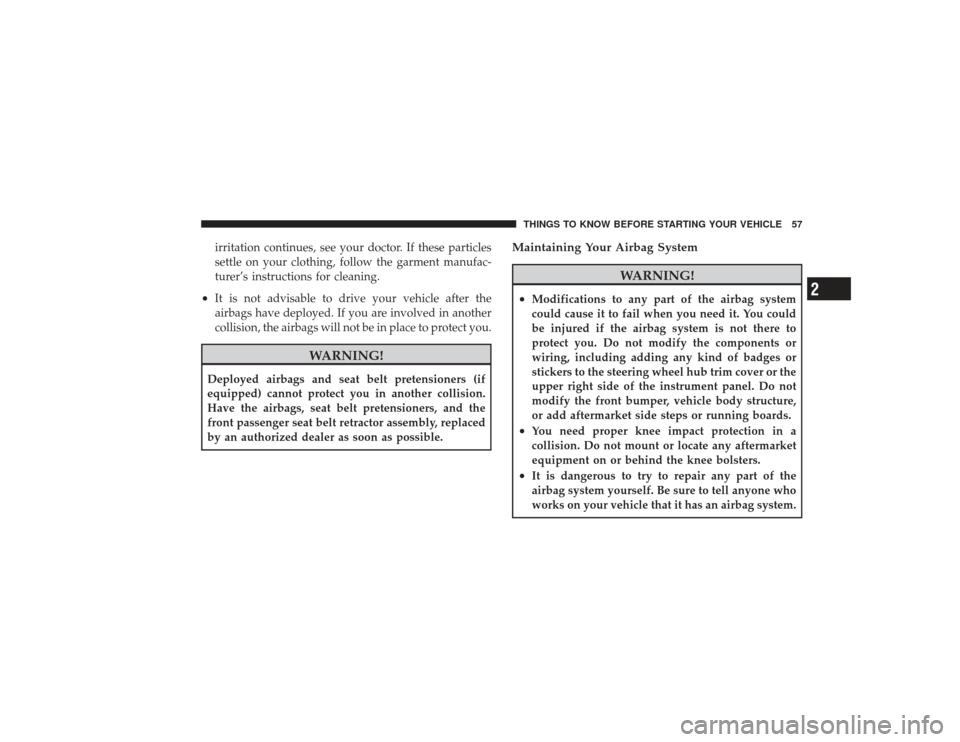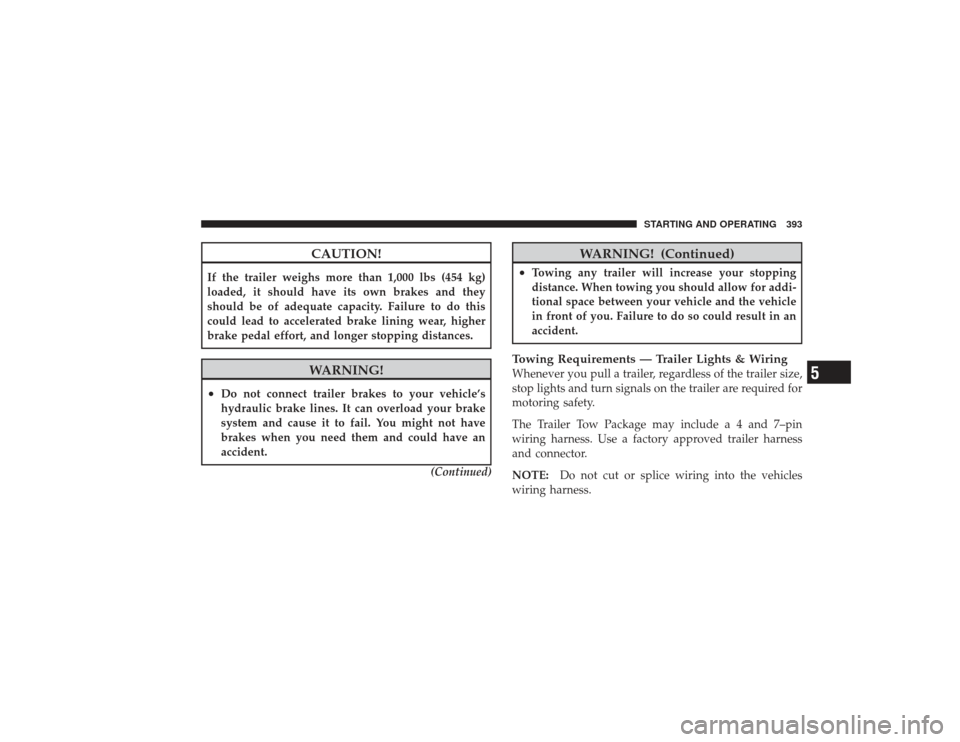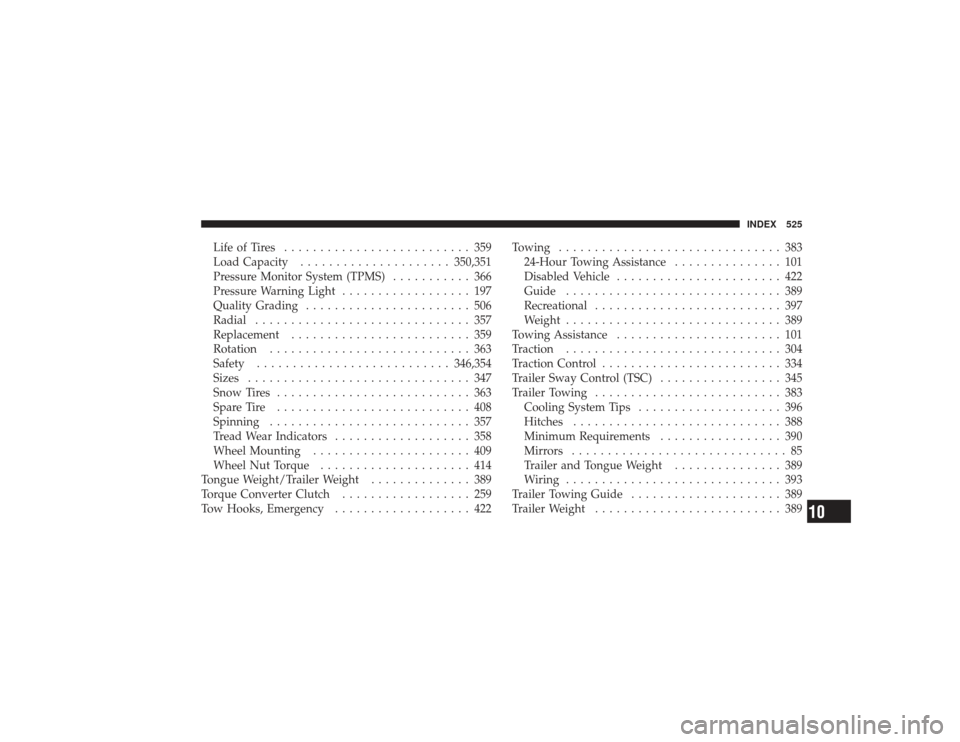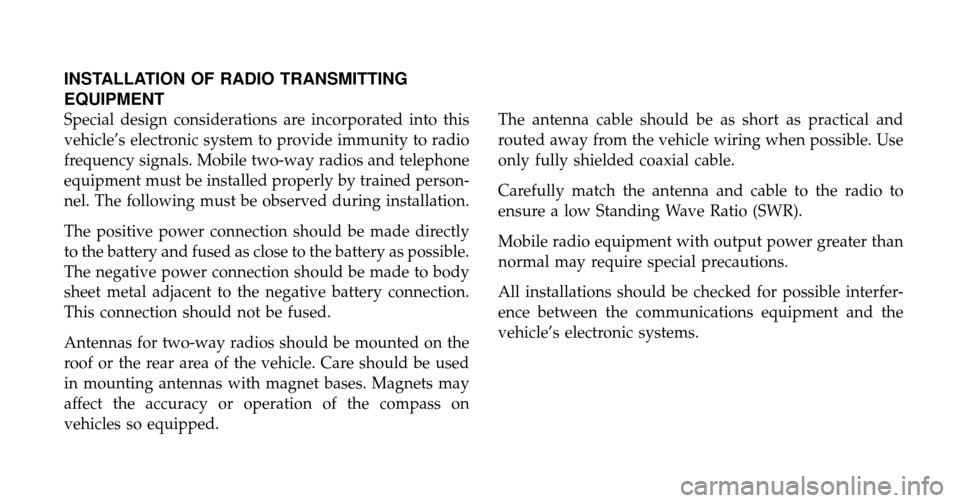2009 DODGE RAM 3500 DIESEL wiring
[x] Cancel search: wiringPage 53 of 532

Airbag System ComponentsThe airbag system consists of the following:•
Occupant Restraint Controller (ORC)
•
Side Remote Acceleration Sensors (if equipped)
•
Airbag Warning Light
•
Driver Airbag
•
Passenger Airbag
•
Window Bags above Side Windows (if equipped)
•
Steering Wheel and Column
•
Instrument Panel
•
Interconnecting Wiring
•
Knee Impact Bolsters
•
Front Acceleration Sensors (1500 Vehicles Only)
•
Driver and Front Passenger Seat Belt Pretensioners (if
equipped)
•
Driver Seat Track Position Sensor (if equipped)
•
Passenger Side Frontal Airbag ON/OFF Switch (2500/
3500 Regular Cab Vehicles Only)
•
Passenger Airbag Disable (PAD) Indicator Light
(2500/3500 Regular Cab Vehicles Only)
How the Airbag System Works
•
TheOccupant Restraint Controller (ORC) determines
if a frontal collision is severe enough to require the
airbags to inflate. The front airbag inflators are de-
signed to provide different rates of airbag inflation
from information provided by the ORC. The ORC will
not detect rollover or rear collisions.
The ORC also monitors the readiness of the electronic
parts of the system whenever the ignition switch is inTHINGS TO KNOW BEFORE STARTING YOUR VEHICLE 51
2
Page 59 of 532

irritation continues, see your doctor. If these particles
settle on your clothing, follow the garment manufac-
turer’s instructions for cleaning.
•
It is not advisable to drive your vehicle after the
airbags have deployed. If you are involved in another
collision, the airbags will not be in place to protect you.
WARNING!
Deployed airbags and seat belt pretensioners (if
equipped) cannot protect you in another collision.
Have the airbags, seat belt pretensioners, and the
front passenger seat belt retractor assembly, replaced
by an authorized dealer as soon as possible.
Maintaining Your Airbag System
WARNING!
•
Modifications to any part of the airbag system
could cause it to fail when you need it. You could
be injured if the airbag system is not there to
protect you. Do not modify the components or
wiring, including adding any kind of badges or
stickers to the steering wheel hub trim cover or the
upper right side of the instrument panel. Do not
modify the front bumper, vehicle body structure,
or add aftermarket side steps or running boards.
•
You need proper knee impact protection in a
collision. Do not mount or locate any aftermarket
equipment on or behind the knee bolsters.
•
It is dangerous to try to repair any part of the
airbag system yourself. Be sure to tell anyone who
works on your vehicle that it has an airbag system.THINGS TO KNOW BEFORE STARTING YOUR VEHICLE 57
2
Page 138 of 532

Multifunction LeverThe multifunction lever, located on the left side of the
steering column, is used to activate the turn signals and
high beams headlights.Turn SignalsMove the lever up or down to signal a right-hand or
left-hand turn.
The arrow on either side of the instrument cluster flashes
to indicate the direction of the turn and proper operation
of the front and rear turn signal lights. If a defective bulb
or wiring circuit is detected for the turn signal system, the
arrow indicators will flash at a faster rate. If an indicator
fails to light when the lever is moved, see your autho-
rized dealer.
Turn Signal Lever
136 UNDERSTANDING THE FEATURES OF YOUR VEHICLE
Page 395 of 532

CAUTION!
If the trailer weighs more than 1,000 lbs (454 kg)
loaded, it should have its own brakes and they
should be of adequate capacity. Failure to do this
could lead to accelerated brake lining wear, higher
brake pedal effort, and longer stopping distances.
WARNING!
•
Do not connect trailer brakes to your vehicle’s
hydraulic brake lines. It can overload your brake
system and cause it to fail. You might not have
brakes when you need them and could have an
accident.(Continued)
WARNING! (Continued)
•
Towing any trailer will increase your stopping
distance. When towing you should allow for addi-
tional space between your vehicle and the vehicle
in front of you. Failure to do so could result in an
accident.
Towing Requirements — Trailer Lights & WiringWhenever you pull a trailer, regardless of the trailer size,
stop lights and turn signals on the trailer are required for
motoring safety.
The Trailer Tow Package may include a 4 and 7–pin
wiring harness. Use a factory approved trailer harness
and connector.
NOTE:Do not cut or splice wiring into the vehicles
wiring harness.
STARTING AND OPERATING 393
5
Page 397 of 532

WARNING!
Any work done to the vehicles electrical system, or
wiring, should be performed by a qualified automo-
tive technician, if done improperly it may cause
damage to the electrical system wiring and could
result in serious or fatal injury.Towing TipsBefore setting out on a trip, practice turning, stopping
and backing the trailer in an area away from heavy
traffic.Automatic TransmissionThe “DRIVE” range can be selected when towing. How-
ever, if frequent shifting occurs while in this range, the
“TOW HAUL” or “OD/OFF” range should be selected.NOTE:
Using the “TOW HAUL” or “OD/OFF” range
while operating the vehicle under heavy operating con-
ditions will improve performance and extend transmis-
sion life by reducing excessive shifting and heat build up.
This action will also provide better engine braking.
The automatic transmission fluid and filter should be
changed if you REGULARLY tow a trailer for more than
45 minutes of continuous operation. Refer to the “Main-
tenance Schedule” in Section 8 for the proper mainte-
nance intervals.
NOTE: Check the automatic transmission fluid level
before towing.
Tow/Haul — If EquippedTo reduce potential for automatic transmission overheat-
ing, turn the “TOW HAUL OD/OFF” feature ON when
driving in hilly areas or shift the transmission to Drive
position 2 on more severe grades.
STARTING AND OPERATING 395
5
Page 527 of 532

Life of Tires.......................... 359
Load Capacity ..................... 350,351
Pressure Monitor System (TPMS) ........... 366
Pressure Warning Light .................. 197
Quality Grading ....................... 506
Radial .............................. 357
Replacement ......................... 359
Rotation ............................ 363
Safety ........................... 346,354
Sizes ............................... 347
Snow Tires ........................... 363
Spare Tire ........................... 408
Spinning ............................ 357
Tread Wear Indicators ................... 358
Wheel Mounting ...................... 409
Wheel Nut Torque ..................... 414
Tongue Weight/Trailer Weight .............. 389
Torque Converter Clutch .................. 259
Tow Hooks, Emergency ................... 422 Towing
............................... 383
24-Hour Towing Assistance ............... 101
Disabled Vehicle ....................... 422
Guide .............................. 389
Recreational .......................... 397
Weight .............................. 389
Towing Assistance ....................... 101
Traction .............................. 304
Traction Control ......................... 334
Trailer Sway Control (TSC) ................. 345
Trailer Towing .......................... 383
Cooling System Tips .................... 396
Hitches ............................. 388
Minimum Requirements ................. 390
Mirrors .............................. 85
Trailer and Tongue Weight ............... 389
Wiring .............................. 393
Trailer Towing Guide ..................... 389
Trailer Weight .......................... 389
INDEX 525
10
Page 531 of 532

INSTALLATION OF RADIO TRANSMITTING
EQUIPMENT
Special design considerations are incorporated into this
vehicle’s electronic system to provide immunity to radio
frequency signals. Mobile two-way radios and telephone
equipment must be installed properly by trained person-
nel. The following must be observed during installation.
The positive power connection should be made directly
to the battery and fused as close to the battery as possible.
The negative power connection should be made to body
sheet metal adjacent to the negative battery connection.
This connection should not be fused.
Antennas for two-way radios should be mounted on the
roof or the rear area of the vehicle. Care should be used
in mounting antennas with magnet bases. Magnets may
affect the accuracy or operation of the compass on
vehicles so equipped.The antenna cable should be as short as practical and
routed away from the vehicle wiring when possible. Use
only fully shielded coaxial cable.
Carefully match the antenna and cable to the radio to
ensure a low Standing Wave Ratio (SWR).
Mobile radio equipment with output power greater than
normal may require special precautions.
All installations should be checked for possible interfer-
ence between the communications equipment and the
vehicle’s electronic systems.